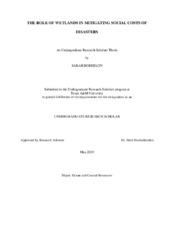| dc.creator | Bordelon, Sarah | |
| dc.date.accessioned | 2021-09-03T16:37:52Z | |
| dc.date.available | 2021-09-03T16:37:52Z | |
| dc.date.created | 2019-05 | |
| dc.date.issued | 2019-04-29 | |
| dc.date.submitted | May 2019 | |
| dc.identifier.uri | https://hdl.handle.net/1969.1/194511 | |
| dc.description.abstract | Social costs associated with disaster recovery in the United States have been on a rise in recent decades given unprecedented number of extreme weather events including floods, coastal storms and hurricanes. Understanding how to proactively manage and mitigate disaster risk has become a priority for many coastal communities. Among many alternatives, nature-based risk management solutions including preservation and restoration of wetlands, mangroves and dunes have been considered increasingly. In this paper, we examine the effectiveness of wetlands in mitigating social costs associated with flooding disasters. Analyzing the data of counties along the Gulf of Mexico coast, we find some empirical evidence that restoring wetlands effectively reduces spending on federal disaster recovery programs. The implication of our research is tremendous given staggering rate of loss of wetlands in the United States and rising number of disasters as well as increasing financial costs of disaster aid. | en |
| dc.format.mimetype | application/pdf | |
| dc.subject | disaster mitigation | en |
| dc.subject | wetlands | en |
| dc.subject | Gulf of Mexico | en |
| dc.subject | coastal disasters | en |
| dc.title | The Role of Wetlands in Mitigating the Social Costs of Disasters | en |
| dc.type | Thesis | en |
| thesis.degree.department | Marine Science | en |
| thesis.degree.discipline | Ocean and Coastal Resources | en |
| thesis.degree.grantor | Undergraduate Research Scholars Program | en |
| thesis.degree.name | BS | en |
| thesis.degree.level | Undergraduate | en |
| dc.contributor.committeeMember | Davlasheridze, Meri | |
| dc.type.material | text | en |
| dc.date.updated | 2021-09-03T16:37:52Z | |


